Exchange Currency
South Korean won
The won is the currency of South Korea. A single won is divided into 100 jeon, the monetary subunit. The jeon is no longer used for everyday transactions, and appears only in foreign exchange rates. One South Korean won (as of May 25, 2010) is equal to 0.114364 North Korean won, at the official North Korean rate.
"Won" is a cognate of the Chinese yuan and Japanese yen. All three names derive from the Hanja, which means "round shape." The won was subdivided into 100 jeon, which means "money", a word of Hanja origin referring to the bronze and copper coins of old.
The first South Korean won was replaced by the hwan on February 15, 1953 at a rate of 1 hwan = 100 won.
In 1946, the Bank of Joseon introduced 10 and 100 won notes. These were followed in 1949 by 5 and 1000 won notes. A new central bank, the Bank of Korea, was established in 1950, and assumed the duties of Bank of Joseon. Notes were introduced (some dated 1949) in denominations of 5, 10 and 50 jeon, 100 and 1000 won. 500 won notes were introduced in 1952. In 1953, a series of banknotes was issued which, although it gave the denominations in English in won, were, in fact, the first issues of the hwan.
The won was reintroduced on June 9, 1962 at a rate of 1 won = 10 hwan. It became the sole legal tender on March 22, 1975 with the withdrawal of the last circulating hwan coins. Its ISO 4217 code is KRW. At the reintroduction of the won in 1962, its value was pegged at 125 won = 1 U.S. dollar. The following pegs operated between 1962 and 1980.
On February 27, 1980, efforts were initiated to lead to a floating exchange rate. The won was finally allowed to float on December 24, 1997 when an agreement was signed with the International Monetary Fund. Shortly after, the won was devalued to almost half of its value, as part of the East Asian financial crisis.
In 1982, with inflation and the increasing popularity of vending machines, 500 won coins were introduced on June 12, 1982. In January 1983, with the purpose of standardizing the coinage, a new series of 1, 5, 10, 50, and 100 won coins were issued, using the same layout as the 500 won coins, but conserving the coins old themes.
The Bank of Korea announced in early 2006 its intention to redesign the 10 won coin by the end of that year. With the increasing manufacturing price, then at 38 won per 10 won coin, and rumors that some people had been melting the coins to make jewelry, the redesign was needed to make the coin more cost effective to produce. The new coin is made of copper-coated aluminum with a reduced diameter of 18 mm, and a weight of 1.22 g. Its visual design is the same as the old coin. The new coin was issued on December 18, 2006. The 1 and 5 won coins are difficult to find in circulation today and prices of consumer goods are rounded to the nearest 10 won. In 1998, the production costs per coin were are as follows: 10 won coins each cost 35 won to produce, 100 won coins cost 58 won, and 500 won coins cost 77 won. The 100 won coins have exactly the same shape as the U.S. quarter.
In 1962, 10 and 50 jeon, 1, 5, 10, 50, 100 and 500 won notes were introduced by the Bank of Korea. The first issue of 1, 5, 10, 50, 100 and 500 won notes were printed in the U.K. by Thomas De La Rue. The jeon notes together with a second issue of 10 and 100 won notes were printed domestically by the Korea Minting and Security Printing Corporation.
In 1965, 100 won notes (Series III) were printed using intaglio printing techniques, for the first time on domestically printed notes, to reduce counterfeiting. Replacements for the British 500 won notes followed in 1966 also using intaglio printing, and for the 50 won notes in 1969 using litho-printing.
With the economic development from the 60s the value of the 500 won notes became lower, resulting in a greater use of cashier's checks with higher fixed denominations as means of payment, as well as an increased use of counterfeited ones. In 1970, the 100 won notes were replaced by coins, with the same happening to the 50 won notes in 1972.
Higher denomination notes of 5000 won and 10,000 won were introduced in 1972 and 1973 respectively. The notes incorporated new security features, including watermark, security thread and ultraviolet response fibres and were inglio printed. The release of 10,000 won notes was planned to be at the same time as the 5000 won notes but problems with the main theme delayed it by a year. Newly designed 500 won notes were also released in 1973 and the need for a medium denomination resulted in the introduction of 1000 won notes in 1975.
In 1982, the 500 won note was replaced by a coin. The following year, as part of its policy of rationalizing the currency system, the Bank of Korea issued a new set of notes, as well as a new set of coins (see above). Some of the note's most notable features were distinguishable marks for the blind under the watermark and the addition of machine-readable language in preparation for mechanization of cash handling. They were also printed on better quality cotton pulp to reduce the production costs by extending their circulation life.
To cope with the deregulation of imports of color printer and the increasing use of computers and scanners, modified 5000 won and 10,000 won notes were released between 1994 and 2002 with various new security features, which included: color-shifting ink, microprint, segmented metal thread, moiré, and EURion constellation. The latest version of the 5000 and 10,000 won are easily identifiable by the copyright information inscribed under the watermark and year of issue on the obverse, " The Bank of Korea" and year of issue on the reverse.
The plates for the 5000 won notes were produced in Japan while the ones for the 1000 and 10,000 won notes were produced by the Korea Minting and Security Printing Corporation. They were all printed in intaglio.
With the release of a new set of notes, no plan has yet been made to withdraw these notes from circulation.
In 2006, it became a major concern that the Korean won banknotes were being counterfeited/forged. Notably the 5000 won note (worth about US$5), over 50% of the notes were confiscated as counterfeit. This led the government to issue a new series of banknotes, with the 5000 won note being the first one to be redesigned. Later in 2007, the 1000 and the 10000 won note was introduced. The banknotes include over 10 security features in each denomination. The 10000 won note has 21 security features, the 5000 won note 17, and the 1000 won note 19. Many modern security features that can be also found in Euros, Pound sterling, Canadian dollar, Japanese yen are included in the banknotes. Some security features inserted in won notes are: Holograms with 3D images that change colors within the metallic foil on the obverse side of the notes(exception of 1000 won) Watermark portraits of the effigy of the note is visible when held to the light in the white section of the note Intaglio printing on words and the effigy give off a raised feeling, different than ordinary paper Security thread in the right side of the obverse side with small lettering "Bank of Korea" and the denominationColor shifting ink on the value number at the back of the note For the first time in the world, the KOMSCO, the Korean mint, inserted a new substance in the notes to detect counterfeits. This technique is being exported to Europe, North America.
"Won" is a cognate of the Chinese yuan and Japanese yen. All three names derive from the Hanja, which means "round shape." The won was subdivided into 100 jeon, which means "money", a word of Hanja origin referring to the bronze and copper coins of old.
Summary info
Summary information about South Korean won- ISO 4217 Code:
- KRW
- Currency sign:
- ₩
- Country:
- Republic of Korea
- Subunit:
- jeon
- Coins:
- 10 won, 50 won, 100 won, 500 won
- Banknotes:
- 1000 won, 5000 won, 10000 won, 50000 won
- Central bank:
- Bank of Korea
History
The won has been in use for thousands of years. During the Colonial era , the won was replaced at par by the yen, made up of the Korean yen. In 1945 after World War II, Korea became divided, resulting in two separate currencies, both called won, for the South and the North. Both the Southern won and the Northern won replaced the yen at par. The first South Korean won was subdivided into 100 jeon. The South Korean won was initially pegged to the U.S. dollar at a rate of 15 won = 1 dollar. A series of devaluations followed, the later ones in part due to the Korean War.The first South Korean won was replaced by the hwan on February 15, 1953 at a rate of 1 hwan = 100 won.
In 1946, the Bank of Joseon introduced 10 and 100 won notes. These were followed in 1949 by 5 and 1000 won notes. A new central bank, the Bank of Korea, was established in 1950, and assumed the duties of Bank of Joseon. Notes were introduced (some dated 1949) in denominations of 5, 10 and 50 jeon, 100 and 1000 won. 500 won notes were introduced in 1952. In 1953, a series of banknotes was issued which, although it gave the denominations in English in won, were, in fact, the first issues of the hwan.
The won was reintroduced on June 9, 1962 at a rate of 1 won = 10 hwan. It became the sole legal tender on March 22, 1975 with the withdrawal of the last circulating hwan coins. Its ISO 4217 code is KRW. At the reintroduction of the won in 1962, its value was pegged at 125 won = 1 U.S. dollar. The following pegs operated between 1962 and 1980.
On February 27, 1980, efforts were initiated to lead to a floating exchange rate. The won was finally allowed to float on December 24, 1997 when an agreement was signed with the International Monetary Fund. Shortly after, the won was devalued to almost half of its value, as part of the East Asian financial crisis.
Coins
Until 1966, 10 and 50 hwan coins, revalued as 1 and 5 won, were the only coins in circulation. New coins, denominated in won, were introduced by the Bank of Korea on August 16, 1966 in denominations of 1, 5 and 10 won, with the 1 won struck in brass and the 5 and 10 won in bronze. These were the first South Korean coins to display the date in the Common era, earlier coins having used the Korean calendar. The 10 and 50 hwan coins were demonetized on March 22, 1975. In 1968, as the intrinsic value of the brass 1 won coin far surpassed its face value, new aluminium 1 won coins were issued to replace them. As an attempt to further reduce currency production costs, new 5 won and 10 won coins were issued in 1970, struck in brass. Cupro-nickel 100 won coins were also introduced that year, followed by Cupro-nickel 50 won in 1972.In 1982, with inflation and the increasing popularity of vending machines, 500 won coins were introduced on June 12, 1982. In January 1983, with the purpose of standardizing the coinage, a new series of 1, 5, 10, 50, and 100 won coins were issued, using the same layout as the 500 won coins, but conserving the coins old themes.
The Bank of Korea announced in early 2006 its intention to redesign the 10 won coin by the end of that year. With the increasing manufacturing price, then at 38 won per 10 won coin, and rumors that some people had been melting the coins to make jewelry, the redesign was needed to make the coin more cost effective to produce. The new coin is made of copper-coated aluminum with a reduced diameter of 18 mm, and a weight of 1.22 g. Its visual design is the same as the old coin. The new coin was issued on December 18, 2006. The 1 and 5 won coins are difficult to find in circulation today and prices of consumer goods are rounded to the nearest 10 won. In 1998, the production costs per coin were are as follows: 10 won coins each cost 35 won to produce, 100 won coins cost 58 won, and 500 won coins cost 77 won. The 100 won coins have exactly the same shape as the U.S. quarter.
Banknotes
The Bank of Korea designates banknote and coin series in a unique way. Instead of putting those of similar design and issue dates in the same series, they assign series number X to the Xth design of for each individual value.In 1962, 10 and 50 jeon, 1, 5, 10, 50, 100 and 500 won notes were introduced by the Bank of Korea. The first issue of 1, 5, 10, 50, 100 and 500 won notes were printed in the U.K. by Thomas De La Rue. The jeon notes together with a second issue of 10 and 100 won notes were printed domestically by the Korea Minting and Security Printing Corporation.
In 1965, 100 won notes (Series III) were printed using intaglio printing techniques, for the first time on domestically printed notes, to reduce counterfeiting. Replacements for the British 500 won notes followed in 1966 also using intaglio printing, and for the 50 won notes in 1969 using litho-printing.
With the economic development from the 60s the value of the 500 won notes became lower, resulting in a greater use of cashier's checks with higher fixed denominations as means of payment, as well as an increased use of counterfeited ones. In 1970, the 100 won notes were replaced by coins, with the same happening to the 50 won notes in 1972.
Higher denomination notes of 5000 won and 10,000 won were introduced in 1972 and 1973 respectively. The notes incorporated new security features, including watermark, security thread and ultraviolet response fibres and were inglio printed. The release of 10,000 won notes was planned to be at the same time as the 5000 won notes but problems with the main theme delayed it by a year. Newly designed 500 won notes were also released in 1973 and the need for a medium denomination resulted in the introduction of 1000 won notes in 1975.
In 1982, the 500 won note was replaced by a coin. The following year, as part of its policy of rationalizing the currency system, the Bank of Korea issued a new set of notes, as well as a new set of coins (see above). Some of the note's most notable features were distinguishable marks for the blind under the watermark and the addition of machine-readable language in preparation for mechanization of cash handling. They were also printed on better quality cotton pulp to reduce the production costs by extending their circulation life.
To cope with the deregulation of imports of color printer and the increasing use of computers and scanners, modified 5000 won and 10,000 won notes were released between 1994 and 2002 with various new security features, which included: color-shifting ink, microprint, segmented metal thread, moiré, and EURion constellation. The latest version of the 5000 and 10,000 won are easily identifiable by the copyright information inscribed under the watermark and year of issue on the obverse, " The Bank of Korea" and year of issue on the reverse.
The plates for the 5000 won notes were produced in Japan while the ones for the 1000 and 10,000 won notes were produced by the Korea Minting and Security Printing Corporation. They were all printed in intaglio.
With the release of a new set of notes, no plan has yet been made to withdraw these notes from circulation.
In 2006, it became a major concern that the Korean won banknotes were being counterfeited/forged. Notably the 5000 won note (worth about US$5), over 50% of the notes were confiscated as counterfeit. This led the government to issue a new series of banknotes, with the 5000 won note being the first one to be redesigned. Later in 2007, the 1000 and the 10000 won note was introduced. The banknotes include over 10 security features in each denomination. The 10000 won note has 21 security features, the 5000 won note 17, and the 1000 won note 19. Many modern security features that can be also found in Euros, Pound sterling, Canadian dollar, Japanese yen are included in the banknotes. Some security features inserted in won notes are: Holograms with 3D images that change colors within the metallic foil on the obverse side of the notes(exception of 1000 won) Watermark portraits of the effigy of the note is visible when held to the light in the white section of the note Intaglio printing on words and the effigy give off a raised feeling, different than ordinary paper Security thread in the right side of the obverse side with small lettering "Bank of Korea" and the denominationColor shifting ink on the value number at the back of the note For the first time in the world, the KOMSCO, the Korean mint, inserted a new substance in the notes to detect counterfeits. This technique is being exported to Europe, North America.
KRW banknotes pictures gallery
| 1000 South Korean won | |
|---|---|
| Banknote of 1000 South Korean won has dimensions 136×68 mm and main colors are periwinkle, alice blue and lavender mist. The issue date of 1000 Korean Won banknote was January 22, 2007. | |
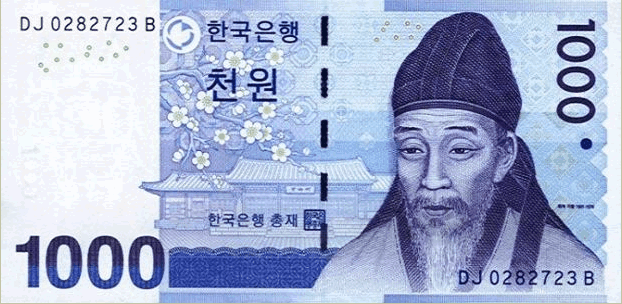 Obverse side of the 1000 South Korean won is showing the portrait of Yi Hwang, Myeongryundang in Seonggyungwan and plum flowers. |
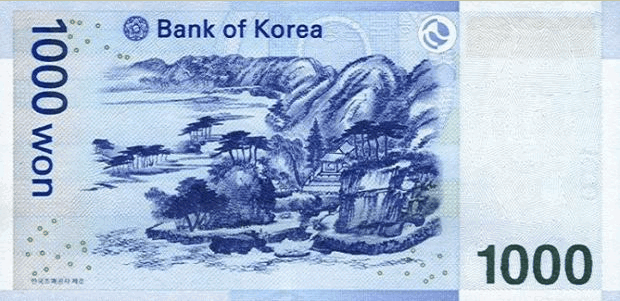 Reverse side of the 1000 South Korean won is showing the "Gyesangjeonggeodo", a painting Yi Hwang in Dosan Seowon by Jeong Seon. |
| 5000 South Korean won | |
|---|---|
| Banknote of 5000 South Korean won has dimensions 142×68 mm and main colors are pale chestnut, desert sand, gainsboro and tea rose. The issue date of 1000 Korean Won banknote was January 2, 2006.. | |
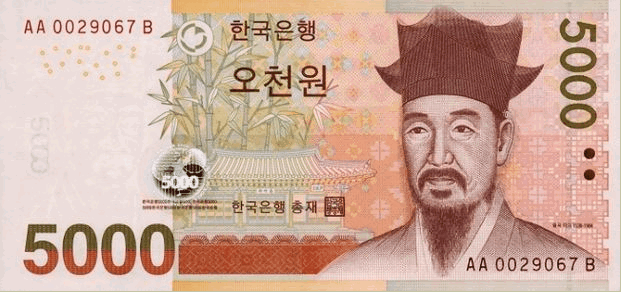 Obverse side of the 5000 South Korean won is showing the portrait of Yi I, Ojukheon in Gangneung and black bamboo. |
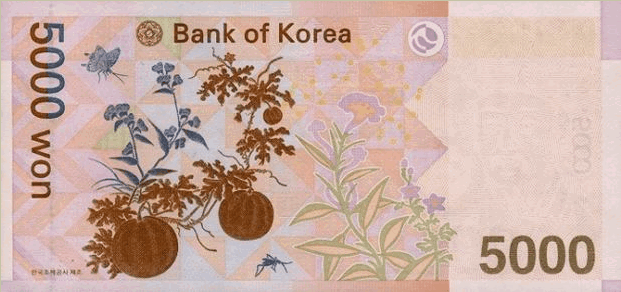 Reverse side of the 5000 South Korean won is showing insects and plants, a painting of a watermelon and cockscombs by Yi I's mother Shin Saimdang. |
| 10000 South Korean won | |
|---|---|
| Banknote of 10000 South Korean won has dimensions 148×68 mm and main colors are payne’s grey, light gray, myrtle and rifle green. The issue date of 1000 Korean Won banknote was January 22, 2007. | |
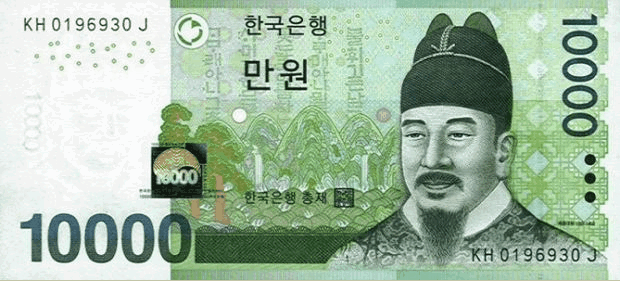 Obverse side of the 10000 South Korean won is showing the portrait of Sejong the Great, Irworobongdo, a folding screen for Joseon-era kings, and text from the second chapter of Yongbieocheonga, the first work of literature written in Korean. |
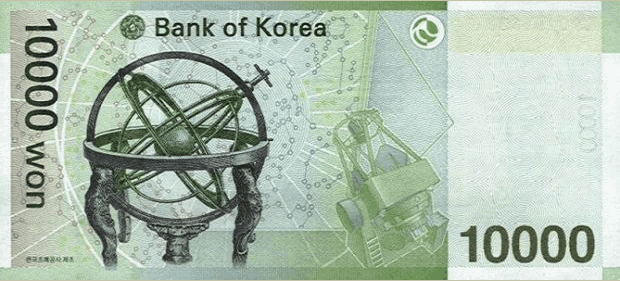 Reverse side of the 10000 South Korean won is showing the Globe of Honcheonsigye and Cheonsang Yeolcha Bunyajido in the background. |
| 50000 South Korean won | |
|---|---|
| Banknote of 50000 South Korean won has dimensions 154×68 mm and main colors are The issue date of 1000 Korean Won banknote was June 23, 2009.. vegas gold, burlywood, onyx and black | |
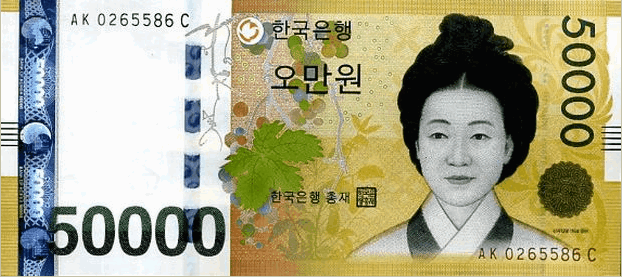 Obverse side of the 50000 South Korean won is showing the portrait of Shin Saimdang with Chochungdo - A Folding Screen of Embroidered Plants and Insects (South Korean National Treasure No. 595) in the background |
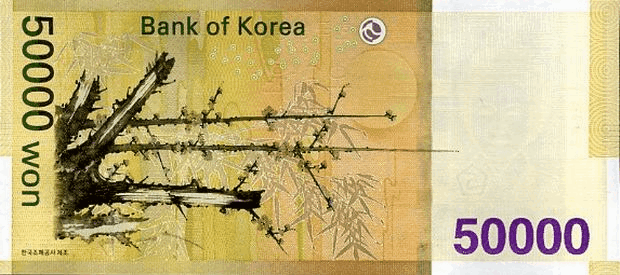 Reverse side of the 50000 South Korean won is showing the Bamboo and a maesil tree. |
Useful links
- About Bank of Korea:
- Bank of Korea
- List of currencies:
- Currencies
- Security and design features of KRW banknotes:
- KRW banknotes
- KRW currency on Wikipedia:
- South Korean won
- Official Website of Bank of Korea:
- eng.bok.or.kr
- Commemorative coins:
- Commemorative Coins